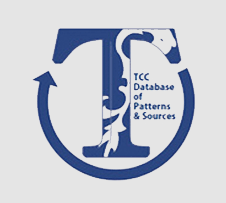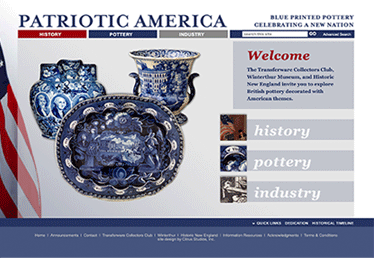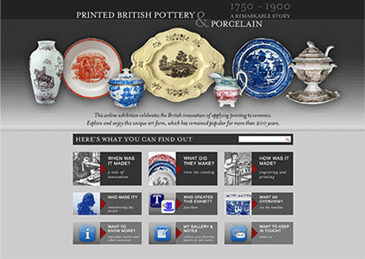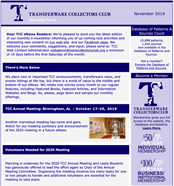


20,032 patterns and 1,190 sources and still growing.
Each month we feature a new pattern from our Pattern and Source Print Database and archive them on these pages.
Members only: for more information about these patterns and to see other similar patterns, search the Pattern and Source Print Database.
(Click on thumbnails to see larger images)
Shown is "Ross & Sons'" Bear Hunting #01. It is a pot lid (lid for a container) that was printed with information about the contents and the name of the manufacturer. This lid advertises Bear’s Grease, which was used as a pomade for men’s hair. The lid was made by F. & R. Pratt (& Co.) 1818-1920. For TCC members, this is Database pattern #6257.
Shown is a pattern known as Fox Hunting - The Death. It is from a series called The Hunting Series. There are 13 patterns from this series in the TCC Database of Patterns and Sources. For TCC members, this is pattern #18325. The maker of this series is unknown. As a point of interest, notice the large birds in the border.
Shown for Thanksgiving is a pattern known as Turkey and Other Birds from the Ornithological Series, by an unknown maker. The pattern appears on a shaped dish and a large jug (with an eagle on the other side of the jug). For TCC members, they are pattern #3325 and pattern #7188, respectively, in the Database of Patterns and Sources.
 The June Pattern of the Month features the fourth of four Rabbitware themes. Rabbitware, an uncommon transferware genre, was produced around the turn of the 20th century (some patterns possibly earlier) for the American market. It is a combination of transfer printing and stick sponge with hand painting. Forms produced include (primarily) plates, chargers, (rarely) oval platters, and (rarely) mugs, small jugs and a few additional, miscellaneous, forms. There are four pattern categories or series. Two series are anthropomorphic: Sports (featured in the February 2025 POM), and Vignette (featured in the April POM). The third category, a much more common series, is Center Rabbits (featured in the March 2025 POM), commonly but not always including frogs!). Finally, the fourth series features various versions of rabbits in the border with stick sponge and hand painted decoration in the center. The maker of the current series is unknown (only the maker of the Sports Series is known). Three of the four border versions include frogs. Rabbits, with frogs, variously face one-way; pairs face each other; rabbits appear in random configuration; and in the fourth variation, are running all in the same direction. The rabbits dominate, but why the addition of frogs? The TCC Database of Patterns and Sources currently documents 12 Rabbitware patterns (simply search under “rabbitware”, with more due to be recorded. For more information, view the DB records and an introductory article on the subject by Siddall and Hoexter in the 2010 Vol. XI no. 1 TCC Bulletin, available to download.
The June Pattern of the Month features the fourth of four Rabbitware themes. Rabbitware, an uncommon transferware genre, was produced around the turn of the 20th century (some patterns possibly earlier) for the American market. It is a combination of transfer printing and stick sponge with hand painting. Forms produced include (primarily) plates, chargers, (rarely) oval platters, and (rarely) mugs, small jugs and a few additional, miscellaneous, forms. There are four pattern categories or series. Two series are anthropomorphic: Sports (featured in the February 2025 POM), and Vignette (featured in the April POM). The third category, a much more common series, is Center Rabbits (featured in the March 2025 POM), commonly but not always including frogs!). Finally, the fourth series features various versions of rabbits in the border with stick sponge and hand painted decoration in the center. The maker of the current series is unknown (only the maker of the Sports Series is known). Three of the four border versions include frogs. Rabbits, with frogs, variously face one-way; pairs face each other; rabbits appear in random configuration; and in the fourth variation, are running all in the same direction. The rabbits dominate, but why the addition of frogs? The TCC Database of Patterns and Sources currently documents 12 Rabbitware patterns (simply search under “rabbitware”, with more due to be recorded. For more information, view the DB records and an introductory article on the subject by Siddall and Hoexter in the 2010 Vol. XI no. 1 TCC Bulletin, available to download.
 Shown is a 15 inch by 11.5 inch platter printed with a pattern known as Date Palm and Royal Barge. The maker of this pattern is unknown. Robert Copeland, in his 2003 Shire book “Blue and White Transfer-Printed Pottery”, illustrates this pattern on a plate, upper right, p. 20. For TCC members, this is pattern #476 in the TCC Database of Patterns and Sources.
Shown is a 15 inch by 11.5 inch platter printed with a pattern known as Date Palm and Royal Barge. The maker of this pattern is unknown. Robert Copeland, in his 2003 Shire book “Blue and White Transfer-Printed Pottery”, illustrates this pattern on a plate, upper right, p. 20. For TCC members, this is pattern #476 in the TCC Database of Patterns and Sources.
 The April Pattern of the Month features the third of four Rabbitware themes. Rabbitware, an uncommon transferware genre, was produced around the turn of the 20th century (some patterns possibly earlier) for the American market. It is a combination of transfer printing and stick sponge with hand painting. Forms produced include (primarily) plates, chargers, (rarely) oval platters, and (rarely) mugs, small jugs and a few additional, miscellaneous, forms. There are four pattern categories or series. Two series are anthropomorphic: Sports (featured in the February POM), and Vignette (featured in this April POM). The two additional, much more common series, are Border Rabbits (pending) and Center Rabbits (featured in our March 2025 POM) (both series commonly but not always including frogs!). We’ll post examples of the third and fourth series in April and May. The maker of the current series is unknown (only the maker of the Sports Series is known). This example is one of three vignette patterns. Each of the three Vignette patterns features four differing cartouches, thus, 12 in total. The individual cartouches appear to be the same for each of the three patterns, but placement around the plate differs, probably at the whim of the employee placing the transfer tissue onto the plate. The TCC Database of Patterns and Sources currently documents 12 Rabbitware patterns (simply search under “rabbitware”, with more due to be recorded; however, all three Vignette groups are recorded. For more information, view the DB records and an introductory article on the subject by Siddall and Hoexter in the 2010 Vol. XI no. 1 TCC Bulletin, available to download.
The April Pattern of the Month features the third of four Rabbitware themes. Rabbitware, an uncommon transferware genre, was produced around the turn of the 20th century (some patterns possibly earlier) for the American market. It is a combination of transfer printing and stick sponge with hand painting. Forms produced include (primarily) plates, chargers, (rarely) oval platters, and (rarely) mugs, small jugs and a few additional, miscellaneous, forms. There are four pattern categories or series. Two series are anthropomorphic: Sports (featured in the February POM), and Vignette (featured in this April POM). The two additional, much more common series, are Border Rabbits (pending) and Center Rabbits (featured in our March 2025 POM) (both series commonly but not always including frogs!). We’ll post examples of the third and fourth series in April and May. The maker of the current series is unknown (only the maker of the Sports Series is known). This example is one of three vignette patterns. Each of the three Vignette patterns features four differing cartouches, thus, 12 in total. The individual cartouches appear to be the same for each of the three patterns, but placement around the plate differs, probably at the whim of the employee placing the transfer tissue onto the plate. The TCC Database of Patterns and Sources currently documents 12 Rabbitware patterns (simply search under “rabbitware”, with more due to be recorded; however, all three Vignette groups are recorded. For more information, view the DB records and an introductory article on the subject by Siddall and Hoexter in the 2010 Vol. XI no. 1 TCC Bulletin, available to download.
 The March Pattern of the Month features the second of four Rabbitware themes. Rabbitware, an uncommon transferware genre, was produced around the turn of the 20th century (some patterns possibly earlier) for the American market. It is a combination of transfer printing and stick sponge with hand painting. Forms produced include (primarily) plates, chargers, (rarely) oval platters, and (rarely) mugs, small jugs and a few additional, miscellaneous, forms. There are four pattern categories or series. Two series are anthropomorphic: Sports (featured in the February POM), and Vignette (pending). The two additional, much more common series, are Border Rabbits (also pending) and Center Rabbits (both series commonly but not always including frogs!). We’ll post examples of the third and fourth series in April and May. The maker of the current and two remaining series is unknown (only the maker of the Sports Series is known).
The March Pattern of the Month features the second of four Rabbitware themes. Rabbitware, an uncommon transferware genre, was produced around the turn of the 20th century (some patterns possibly earlier) for the American market. It is a combination of transfer printing and stick sponge with hand painting. Forms produced include (primarily) plates, chargers, (rarely) oval platters, and (rarely) mugs, small jugs and a few additional, miscellaneous, forms. There are four pattern categories or series. Two series are anthropomorphic: Sports (featured in the February POM), and Vignette (pending). The two additional, much more common series, are Border Rabbits (also pending) and Center Rabbits (both series commonly but not always including frogs!). We’ll post examples of the third and fourth series in April and May. The maker of the current and two remaining series is unknown (only the maker of the Sports Series is known).
This example is one of five rabbit center patterns. The patterns vary in number and positions of the rabbits; whether a frog is present, or not; and whether trees and a fence are present in the background. All five patterns also appear within somewhat differing sponge/painted surrounds. The painter(s) obviously followed certain guidelines but were allowed a lot of creative freedom within these guidelines. The TCC Database of Patterns and Sources currently documents 12 Rabbitware patterns (simply search under “rabbitware”, with more due to be recorded. For more information, view the DB records and an introductory article on the subject by Siddall and Hoexter in the 2010 Vol. XI no. 1 TCC Bulletin, available to download.
 Rabbitware, an uncommon transferware genre, was produced around the turn of the 20th century (some patterns possibly earlier) for the American market (as exemplified by eBay offerings only from American sellers, and a printed mark indicating Smith Patterson Company, a Boston importer). It is a combination of transfer printing and stick sponge with hand painting. Forms produced include (primarily) plates, chargers, (rarely) oval platters, and (rarely) mugs, small jugs and a few additional, miscellaneous, forms. There are four pattern categories or series. Two series are anthropomorphic: Sports (including this example, Rabbits Playing Baseball, one of six in the Sports series), and Vignette. The two additional, much more common series, are Border Rabbits and Center Rabbits (both series commonly including frogs!). We’ll post examples of each series over following months. The maker of the Sports Series is William Baker & Co, High Street, Fenton, Stoke-on-Trent (1839 - 1932), identified by the registration number shown on the reverse. This example is Rabbits Playing Baseball; each of the six Sports Series patterns dates 1905, as identified by its registration number. The maker(s) of the other three series is (are) unknown, as the wares are never marked. The TCC Database of Patterns and Sources currently documents 12 Rabbitware patterns (simply search under “rabbitware”, with more (including the example shown herein) due to be recorded. For more information, view the DB records and an introductory article on the subject by Siddall and Hoexter in the 2010 Vol. XI no. 1 TCC Bulletin, available to download at https://www.transferwarecollectorsclub.org/bulletin_previews/articles/2010_Winter_TCCBulletin_Feature.pdf.
Rabbitware, an uncommon transferware genre, was produced around the turn of the 20th century (some patterns possibly earlier) for the American market (as exemplified by eBay offerings only from American sellers, and a printed mark indicating Smith Patterson Company, a Boston importer). It is a combination of transfer printing and stick sponge with hand painting. Forms produced include (primarily) plates, chargers, (rarely) oval platters, and (rarely) mugs, small jugs and a few additional, miscellaneous, forms. There are four pattern categories or series. Two series are anthropomorphic: Sports (including this example, Rabbits Playing Baseball, one of six in the Sports series), and Vignette. The two additional, much more common series, are Border Rabbits and Center Rabbits (both series commonly including frogs!). We’ll post examples of each series over following months. The maker of the Sports Series is William Baker & Co, High Street, Fenton, Stoke-on-Trent (1839 - 1932), identified by the registration number shown on the reverse. This example is Rabbits Playing Baseball; each of the six Sports Series patterns dates 1905, as identified by its registration number. The maker(s) of the other three series is (are) unknown, as the wares are never marked. The TCC Database of Patterns and Sources currently documents 12 Rabbitware patterns (simply search under “rabbitware”, with more (including the example shown herein) due to be recorded. For more information, view the DB records and an introductory article on the subject by Siddall and Hoexter in the 2010 Vol. XI no. 1 TCC Bulletin, available to download at https://www.transferwarecollectorsclub.org/bulletin_previews/articles/2010_Winter_TCCBulletin_Feature.pdf.
 Shown is a Josiah Wedgwood (1759-2005) platter printed with the Water Lily #01 pattern. This is the original version of the Water Lily pattern, that proved to be too expensive to make. It was replaced in 1811, when Josiah II said that it would be removed from display. He added that the pattern would be reissued in blue with an altered border. For TCC members, see pattern #16308 and pattern #1652 in the TCC Database of Patterns and Sources for more information.
Shown is a Josiah Wedgwood (1759-2005) platter printed with the Water Lily #01 pattern. This is the original version of the Water Lily pattern, that proved to be too expensive to make. It was replaced in 1811, when Josiah II said that it would be removed from display. He added that the pattern would be reissued in blue with an altered border. For TCC members, see pattern #16308 and pattern #1652 in the TCC Database of Patterns and Sources for more information.
Shown on a 1.7 inches high pot, from an unknown maker. The pattern is a rebus: a combination of words and pictures. Click on the heading of this entry to view the additional images on the pot. The advertisement is for a hair restorer. The pattern uses the words, The, Deal, and Restorer. The pictures that replace the words, I and Hair, are an eye and a hare. The pattern is clever and attractive, which is what you would want for an advertisment that holds your product. The pot or container probably had a paper lid or a paper band that included the name of the maker or retailer plus other information about the product. For TCC members, this is pattern #17852 in the Database of Patterns and Sources. To see other patterns that advertise hair products, search Advertising/Hair Products/Pomades in the database.
Rich with content for ceramic collectors, researchers, authors, curators, and historic archaeologists, the sites are sure to deliver value for their visitors. The exhibition’s curators continue to enhance them and, now, with site application upgrades, including a new magnification feature and upgraded content management capabilities, the TCC and its collaborators are pleased to relaunch these exhibits, all free to a worldwide audience.

Branded Patriotic America, debuted in 2014 in collaboration with Historic New England, and the Winterthur Museum

Launched in 2015 in partnership with the Northern Ceramic Society.
 Not a member but want to receive email updates?
Not a member but want to receive email updates?